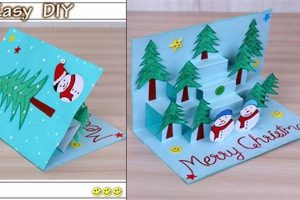Handmade presents for educators during the holiday season represent a thoughtful gesture of appreciation. These items are created by students or their families and given to teachers as tokens of gratitude around Christmas. Examples include personalized ornaments, baked goods, handwritten notes, or small crafts tailored to the educator’s interests.
The practice of giving gifts to teachers at Christmas serves to strengthen the bonds between educators, students, and their families. It acknowledges the teacher’s hard work and dedication throughout the year. Furthermore, creating presents can be a valuable activity that fosters creativity, resourcefulness, and a sense of community engagement. This tradition provides a tangible way for students to express thankfulness and recognize the impact of their instructors.
The subsequent sections will delve into specific ideas, practical tips, and considerations for creating memorable and impactful presents that are both budget-friendly and personally meaningful. It will also address ethical aspects and best practices for gift-giving in educational settings.
Guidance for Handmade Holiday Presents for Educators
The following guidelines offer practical advice for creating thoughtful and appropriate handmade holiday presents for educators.
Tip 1: Prioritize Personalization. The value of a handmade gift lies in its ability to reflect the recipient’s unique interests. Consider the teacher’s favorite subject, hobbies, or classroom themes when selecting a project.
Tip 2: Emphasize Functionality. While decorative items are appreciated, practical gifts that can be utilized in the classroom or at home often provide lasting value. Examples include personalized stationery, a handmade desk organizer, or a set of useful tools for their subject.
Tip 3: Adhere to School Policies. Before embarking on a project, consult school guidelines regarding gift-giving. Some institutions may have restrictions on the types of gifts accepted or their monetary value.
Tip 4: Involve the Student. The student’s participation in the creation process adds a personal touch and demonstrates genuine appreciation. Even simple contributions, such as writing a heartfelt card or adding a decorative element, enhance the gift’s significance.
Tip 5: Consider Dietary Restrictions and Allergies. If planning to create edible gifts, ensure awareness of any dietary restrictions or allergies the teacher may have. Provide a clear list of ingredients to avoid potential health concerns.
Tip 6: Focus on Presentation. The manner in which a gift is presented can enhance its impact. A neatly wrapped present with a handwritten tag conveys thoughtfulness and care.
Tip 7: Opt for Group Projects. Pooling resources with other students to create a larger, more elaborate item can be a cost-effective and collaborative approach. This allows for a more substantial present while still adhering to budget constraints.
By following these guidelines, one can create handmade gifts that are both meaningful and appropriate, fostering positive relationships between students, families, and educators.
The subsequent section will address safety considerations and age-appropriate gift suggestions to ensure a positive and responsible approach to creating and presenting holiday gifts.
1. Personalized appreciation
Personalized appreciation, as it relates to handmade holiday presents for educators, centers on tailoring gifts to reflect the unique attributes, interests, or needs of the individual teacher. This approach moves beyond generic presents, emphasizing thoughtfulness and recognizing the teacher’s specific contributions.
- Reflecting Individual Interests
This involves identifying a teacher’s personal hobbies or subject matter preferences. For example, a teacher passionate about botany might appreciate a handcrafted terrarium, while a literature enthusiast could value a personalized bookmark featuring a quote from their favorite author. Such gifts demonstrate a genuine effort to understand and acknowledge the teacher’s individuality.
- Addressing Classroom Needs
Personalized appreciation can extend to addressing the practical needs of the classroom. A handmade set of organizational containers labeled with the teacher’s name or subject area offers both utility and a personal touch. Similarly, a customized teaching aid related to a specific curriculum topic can enhance the learning experience and show support for the teacher’s educational efforts.
- Expressing Specific Gratitude
Handmade gifts provide an opportunity to express specific gratitude for the teacher’s impact on the student. A handwritten note detailing how the teacher has positively influenced the student’s learning or personal growth adds a layer of heartfelt appreciation. This approach transcends material value, emphasizing the emotional connection between student and educator.
- Incorporating Shared Experiences
Gifts that reference shared experiences, such as a class project or a memorable event, can further personalize the gesture. For instance, a framed photograph of the class engaged in a particularly successful activity, accompanied by student signatures, serves as a tangible reminder of positive interactions and collective achievements.
Ultimately, personalized appreciation in the context of handmade presents elevates the act of gift-giving to a more meaningful and impactful exchange. It signifies a deliberate effort to recognize the teacher as an individual, acknowledging their contributions and fostering a stronger sense of connection within the educational environment.
2. Budget-friendly solutions
Budget-friendly solutions are integral to the creation of handmade holiday presents for educators. The economic considerations involved in this type of gifting necessitate resourcefulness and creativity to produce meaningful tokens of appreciation without incurring excessive expense. Affordability enables broader participation and ensures that the sentiment behind the gift remains the focal point.
- Repurposed Materials
The utilization of repurposed materials represents a significant avenue for cost reduction. Items such as recycled paper, fabric scraps, or reclaimed wood can be transformed into functional and aesthetically pleasing gifts. For instance, fabric remnants can be sewn into personalized pouches for stationery, while repurposed glass jars can be decorated and used as desk organizers. This approach not only minimizes expense but also promotes environmental consciousness.
- DIY Ingredients and Supplies
Crafting presents using readily available and inexpensive ingredients or supplies found at home is another cost-effective strategy. Homemade baked goods, such as cookies or muffins, require basic baking ingredients. Similarly, hand-poured candles can be created using wax remnants and essential oils. Sourcing materials from existing household supplies reduces the need for additional purchases.
- Bulk Purchases and Shared Resources
When pursuing handmade projects, bulk purchases of craft supplies can often yield significant savings. Coordinating with other students or families to pool resources and share materials allows for the procurement of larger quantities at lower unit costs. This collaborative approach extends the budget and enables the creation of more elaborate or numerous gifts.
- Simplified Designs and Techniques
Opting for simplified designs and techniques in crafting handmade presents is essential for maintaining affordability. Intricate projects that demand specialized tools or extensive time investment can quickly escalate costs. Focusing on straightforward designs and readily mastered techniques ensures that the gifts remain within budgetary constraints.
In summary, budget-friendly solutions facilitate the creation of thoughtful and personalized holiday presents for educators. By employing resourceful strategies such as repurposing materials, utilizing DIY ingredients, sharing resources, and simplifying designs, individuals can express their appreciation without financial strain. These approaches underscore the intrinsic value of handmade gifts, emphasizing the sentiment behind the gesture over monetary worth.
3. Meaningful expression
Meaningful expression, within the context of handmade holiday presents for educators, serves as the foundational element that elevates a simple item into a sincere gesture of gratitude. The act of creating a gift, rather than purchasing one, inherently allows for the infusion of personal sentiments and a tangible representation of the student’s or family’s appreciation. This intrinsic value surpasses the monetary worth of a store-bought item, establishing a deeper connection between giver and recipient. For instance, a hand-painted portrait of a teacher’s pet conveys a level of thoughtfulness and understanding that a generic gift card cannot replicate. The effect of this personalization is a heightened sense of value for the educator, who recognizes the effort and consideration involved.
The importance of meaningful expression is underscored by the potential for handmade gifts to reflect specific moments or achievements within the classroom. A class-created scrapbook documenting a particularly successful field trip or a challenging project that resulted in significant student growth serves as a lasting reminder of shared experiences. Such gifts not only acknowledge the teacher’s dedication but also reinforce the positive impact of their work on the students’ learning journey. Furthermore, the inclusion of a handwritten note expressing gratitude for specific actions or guidance provided by the teacher personalizes the gift further, reinforcing the message of appreciation in a direct and sincere manner.
In conclusion, the connection between meaningful expression and the practice of creating holiday gifts for educators lies in the ability to convey sincere appreciation through personalized and thoughtful actions. The challenge lies in ensuring that the chosen gift aligns with the teacher’s interests and reflects a genuine understanding of their contributions. By prioritizing meaningful expression over monetary value, the gift becomes a powerful symbol of gratitude, fostering a stronger connection between students, families, and the educators who shape their lives. This understanding highlights the practical significance of emphasizing personalization and heartfelt gestures in the tradition of gift-giving during the holiday season.
4. Unique creations
The correlation between unique creations and handmade holiday presents for educators lies in the enhanced personal value and memorability associated with such items. The act of crafting a distinct present signifies a level of effort and thoughtfulness exceeding that of a commercially available alternative. This uniqueness is often a direct result of personalization, reflecting specific aspects of the teacher’s personality, interests, or classroom environment. For example, a teacher known for their love of reading might receive a handcrafted bookmark featuring a quote from their favorite author, while an educator passionate about environmental science could be presented with a miniature terrarium created from recycled materials. The effect is a more meaningful and appreciated gift.
The importance of unique creations as a component of handmade holiday presents is further highlighted by their capacity to strengthen relationships between students, families, and educators. A generic gift may be well-received, but a handcrafted, unique item communicates a deeper level of understanding and appreciation. This can lead to stronger teacher-student bonds and a more positive classroom environment. Furthermore, these items often serve as lasting reminders of the specific class or school year, evoking fond memories and reinforcing the positive impact of the teacher’s efforts. Consider a class collectively crafting a quilt, with each student contributing a square representing a significant event or lesson from the year. The finished product represents a tangible embodiment of shared experiences and collaborative effort, rendering it far more valuable than a commercially produced quilt.
In conclusion, the focus on unique creations within the domain of handmade holiday presents for educators directly enhances the value and impact of the gift. This strategy promotes deeper appreciation, strengthens relationships, and creates lasting memories. While challenges may arise in terms of time commitment or creative execution, the benefits of prioritizing uniqueness ultimately contribute to a more meaningful and positive holiday experience for both giver and recipient. The ability to craft items that reflect specific attributes and experiences solidifies the role of handmade gifts as powerful expressions of gratitude.
5. Thoughtful gestures
The significance of thoughtful gestures in relation to handmade holiday presents for educators underscores the deeper implications of gift-giving beyond mere material exchange. This approach focuses on the intent and consideration behind the gift, emphasizing personal connection and genuine appreciation.
- Recognizing Individual Preferences
Acknowledging a teachers specific interests or hobbies demonstrates attentiveness and consideration. A present aligning with these preferences, such as a collection of teas for a tea enthusiast or a handmade item reflecting a teachers favorite literary character, resonates more profoundly than a generic offering. This individualized approach elevates the gift from a perfunctory obligation to a meaningful acknowledgement of the educator as an individual.
- Incorporating Student Contributions
Involving students in the creation process amplifies the gestures sincerity. Even simple contributions, such as handwritten notes expressing gratitude or decorative elements added to the gift, enhance its emotional value. This collaborative effort reflects the collective appreciation of the class and fosters a stronger sense of community within the classroom environment. It transforms the present from a singular act of giving into a shared expression of thankfulness.
- Addressing Practical Needs
Thoughtful gestures can also extend to addressing practical needs within the classroom setting. A handmade organizer for classroom supplies or a personalized teaching aid demonstrates an understanding of the challenges and requirements of the educator’s role. These functional gifts, while not necessarily extravagant, offer tangible support and acknowledge the teachers dedication to their profession. This approach reflects a pragmatic form of appreciation, focusing on utility and support.
- Timing and Presentation
The timing and presentation of the gift contribute significantly to its perceived thoughtfulness. Presenting the gift at a moment when it will be particularly appreciated, such as after a challenging project or during a period of increased stress, amplifies its impact. A well-wrapped present accompanied by a heartfelt card further enhances the gesture, conveying sincerity and care. These details elevate the act of gift-giving from a simple transaction to a deliberate expression of gratitude.
The combination of these facets underscores the importance of thoughtful gestures in the context of handmade holiday presents for educators. By prioritizing individual preferences, incorporating student contributions, addressing practical needs, and attending to timing and presentation, the act of giving transforms into a powerful expression of appreciation and connection. This approach emphasizes the human element within the educational environment, fostering stronger relationships and reinforcing the value of genuine gratitude.
6. Practical applications
The relevance of practical applications within the framework of creating holiday presents for educators lies in the ability to provide gifts that serve a tangible purpose in the classroom or the teacher’s personal life. This approach focuses on items that are not merely decorative but offer utility and functionality, thereby increasing their value and likelihood of long-term use.
- Classroom Organization Tools
Creating organizational tools tailored to the teachers specific needs and subject matter offers immediate practical benefit. Examples include customized storage containers for art supplies, labeled dividers for file cabinets, or a handmade desk organizer. Such gifts contribute directly to a more efficient and orderly classroom environment, supporting the teachers daily tasks.
- Teaching Aids and Resources
Handmade teaching aids relevant to the teachers curriculum provide valuable instructional support. This may involve creating flashcards for vocabulary lessons, building a miniature model for a science unit, or designing interactive learning games. These resources supplement existing classroom materials and enhance the students learning experience, demonstrating a direct contribution to the teachers pedagogical efforts.
- Personalized Stationery and Supplies
Providing personalized stationery and supplies offers practical support for communication and administrative tasks. Examples include customized notepads, thank-you notes, or a set of personalized pens. These items not only streamline the teachers daily workflow but also reflect a personal touch, enhancing their sense of appreciation and value.
- Comfort and Wellness Items
Gifts promoting comfort and well-being address the demands and stresses associated with teaching. A handmade aromatherapy diffuser, a personalized water bottle, or a set of hand-knitted warmers for cold days offer tangible support for the teachers physical and emotional well-being. These presents acknowledge the teachers dedication and provide practical means for self-care.
The emphasis on practical applications within the realm of crafting holiday gifts for educators enhances the value and impact of the present. These items directly support the teachers professional and personal lives, demonstrating a level of thoughtfulness that transcends purely decorative offerings. Prioritizing utility ensures that the gift serves a sustained purpose, fostering a deeper sense of appreciation and connection between the giver and the recipient.
Frequently Asked Questions
The following section addresses common inquiries regarding the creation and presentation of handmade holiday gifts to educators, aiming to provide clarity and guidance on best practices.
Question 1: What is the appropriate monetary value for a handmade present?
The inherent value of a handmade present lies in the thoughtfulness and effort invested, rather than its monetary worth. It is advisable to prioritize sentiment and practicality over extravagant materials or elaborate designs. Reference school policies regarding gift-giving guidelines, which may outline specific restrictions on gift value.
Question 2: How can a student involve themselves in the creation process if they lack crafting skills?
Student involvement can extend beyond complex crafting techniques. Simple contributions such as writing a heartfelt card, decorating packaging, or gathering necessary materials contribute to the personal touch of the present. The participation, regardless of skill level, is what is important.
Question 3: What types of gifts are generally considered inappropriate?
Gifts of significant monetary value, overly personal items (such as clothing or perfume), or items that violate school policies should be avoided. Refrain from giving alcohol or other items that may be perceived as inappropriate within a professional setting.
Question 4: How can dietary restrictions or allergies be addressed when making edible gifts?
Inquire about any known dietary restrictions or allergies the teacher may have. Clearly label all ingredients used in edible gifts to mitigate potential health risks. When in doubt, consider alternatives such as non-edible handmade items.
Question 5: Is it appropriate to create a group gift with other students?
Group gifts offer a cost-effective and collaborative approach to creating more substantial items. Coordinating with other students allows for the pooling of resources and the creation of a gift that reflects the collective appreciation of the class. A single, quality item created collectively is often preferable to multiple smaller gifts.
Question 6: What is the best way to present the gift to the teacher?
Present the gift in person with a sincere expression of gratitude. A handwritten card detailing specific reasons for appreciation adds a personal touch. Respect the teacher’s time and avoid disrupting instructional activities. The gesture is best made privately and respectfully.
By adhering to these guidelines, individuals can create and present handmade holiday gifts that are both meaningful and appropriate, fostering positive relationships within the educational environment.
The subsequent section will provide a summary and conclusion, highlighting the key benefits and considerations involved in creating meaningful handmade holiday presents for educators.
Conclusion
The preceding exploration of “christmas teacher gifts diy” has underscored its potential as a meaningful and personalized expression of gratitude towards educators during the holiday season. It has examined the multifaceted aspects, ranging from the importance of personalized appreciation to the pragmatism of budget-friendly solutions. Further, it has highlighted that such items transcend mere material value by providing unique creations and thoughtful gestures that build stronger relationships between students, families, and teachers.
The enduring value of these handmade items lies in their ability to convey sincere appreciation and create lasting memories. While the challenges of time commitment and skill level may present obstacles, the benefits of creating truly personalized tokens of gratitude ultimately outweigh these concerns. It is through such genuine expressions that the spirit of the holiday season is best exemplified, solidifying the vital connection between educators and the communities they serve. Therefore, conscientious planning and thoughtful execution should guide the creation of these presents.


![Unique DIY Gifts Dad Christmas Ideas [Handmade!] The DIY Hub: Creative Crafts, Repairs & Life Hacks Unique DIY Gifts Dad Christmas Ideas [Handmade!] | The DIY Hub: Creative Crafts, Repairs & Life Hacks](https://craftingdiycenter.com/wp-content/uploads/2025/07/th-3806-300x200.jpg)




